So I finally made a blog post on vegan macarons! If you guys follow me on instagram you’ll see that I make vegan macarons A LOT! They were actually the first thing that I tried to learn when I started baking. I actually have a very in-depth tutorial in my instagram highlights HERE.
For all intents and purposes, macarons are potentially THE hardest thing to bake for home bakers. They are massively prone to error and you have to control every single variable to the most minute detail. Temperature, Humidity. Timing. Weighing ingredients to the gram. You know the drill! If this is your first time making macarons, it’s almost guaranteed you will fail the first time. It took me 8-10 times before I started getting perfect batches.
There’s multiple egg replacements you can use for vegan macarons but I shall be using aquafaba. If you have no idea what aquafaba is or how to use it – please see my how-to guide on aquafaba here! If you have some aquafabulous experience then check out my index of recipes that contain aquafaba!
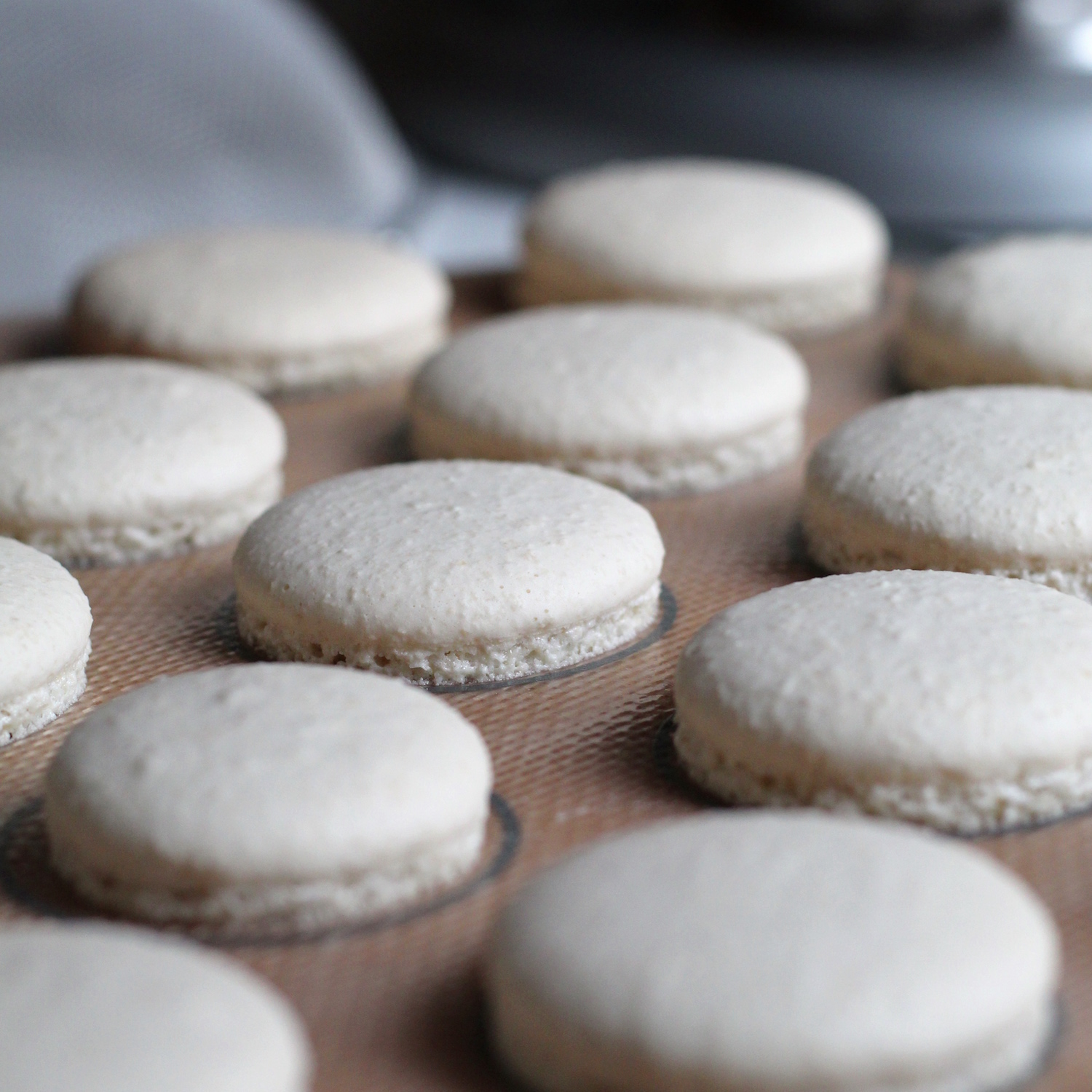
There a fair few vegan macaron recipes online but you’ll find that mine is quite unique as I use a vegan version of the Swiss method.
When deciding on a method, two thoughts came to mind: which is the easiest and which is the most effective? French is by far the easiest method but the drawbacks are that the meringue isn’t very stable. Italian is the most glamorous method, and often the most effective, but you need a sugar thermometer to make it! Swiss is therefore my go-to choice.
It is even more optimal in a vegan meringue because we don’t have to worry about “overcooking” the aquafaba like you would with egg whites. In fact, my recipe entails cooking the aquafaba down with the sugar to make it more potent and sturdy. We’ll get there soon!
Let’s jump straight into the technical side of this process. I’m going to separate this discussion into 3 topics: equipment, chemistry and method.
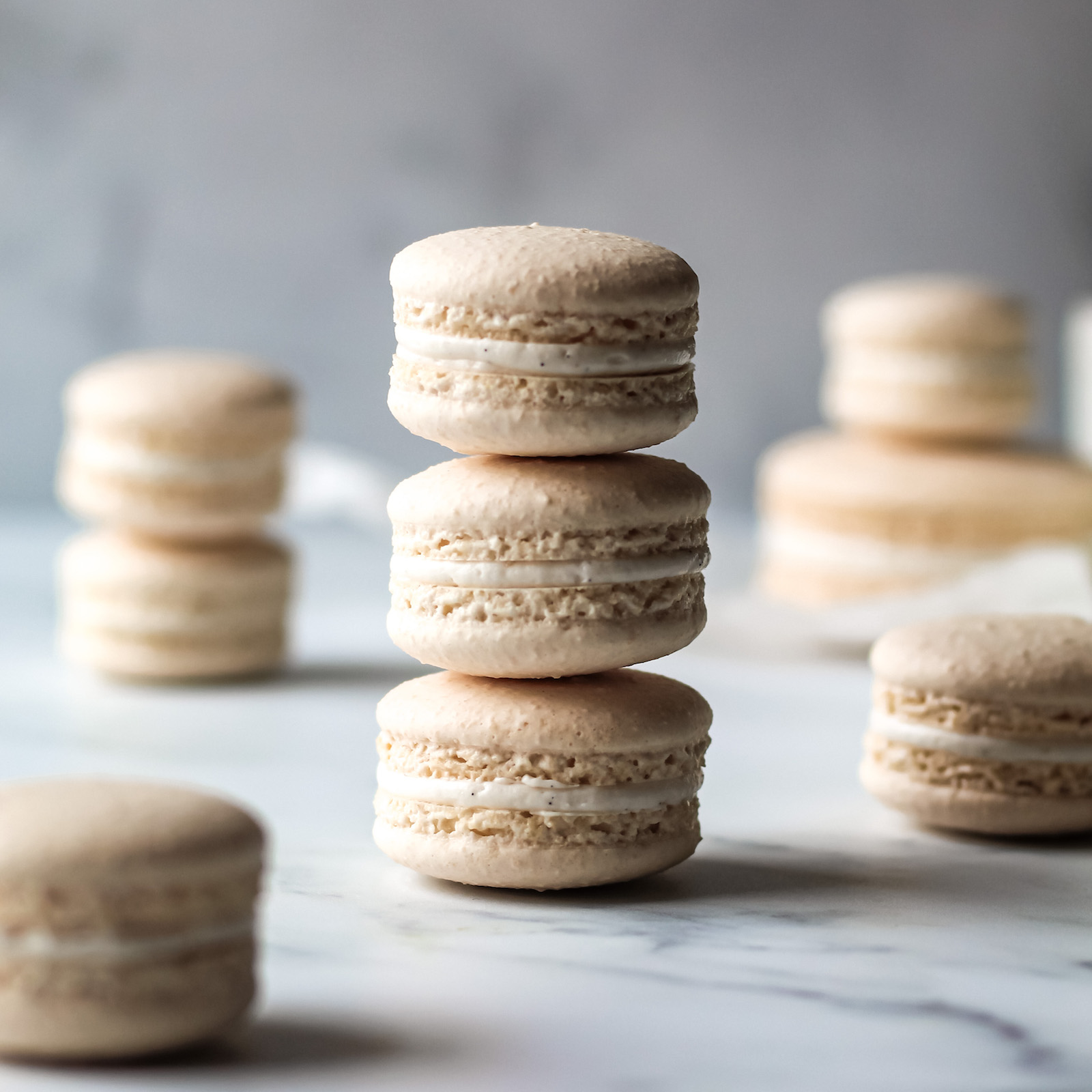
Equipment:
For this recipe you’ll need the following equipment:
- stand mixer / electric whisk
- accurate scale
- fine mesh sieve
- baking trays + parchment paper/silicone mat
- piping bag + 1cm circular nozzle
- oven (seems obvious but I get a lot of questions if you can make macarons in toaster ovens or microwave… )
A stand mixer or electric whisk is fairly essential to this process. It is *technically* possible to whip up a meringue by hand but it will take at least 20 minutes and your arms will hate you for it! Make sure your bowl and whisk are clean before you start this process. I like to wipe down my utensils with apple cider vinegar which is a neutralising acid and also helps stabilise meringue.
An accurate scale is an absolute must. Macarons are a science and just like in a chemistry lab, everything needs to be weighed to the gram. This cannot be achieved with guesswork or with cups.
Thirdly, in order to get smooth macarons you will need to sieve your icing sugar and almond flour together.
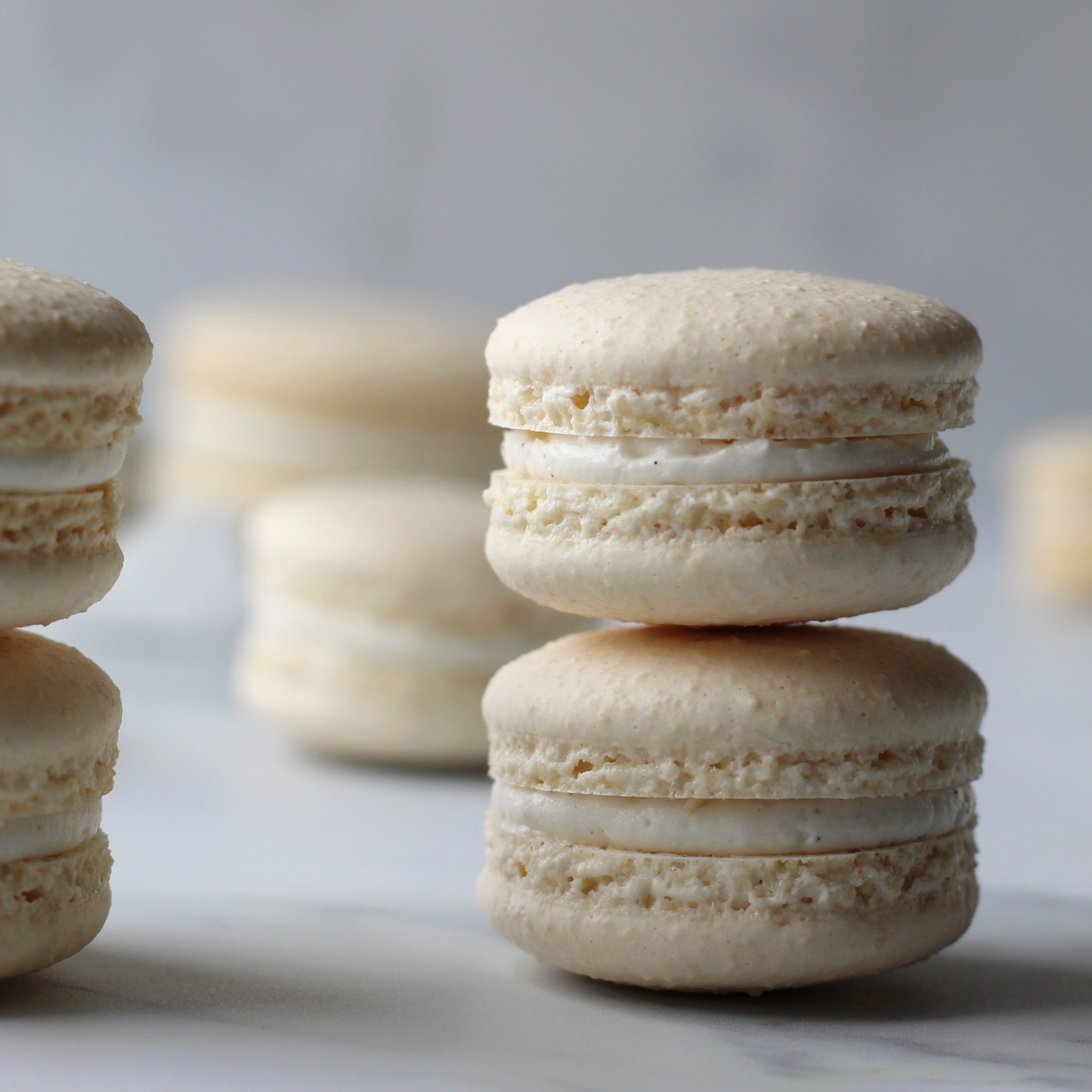

You’ll typically need 2 or more baking trays for this recipe as you’ll need to spread out the macarons enough so that they don’t touch. A hidden variable that is often the cause for failed macarons is the type of baking tray that is being used. A cheap metal baking tray can often cause macarons to explode because the metal is thin and conducts heat very quickly. This rapid change in heat causes macarons to rise too quickly and explode. This is even more common in vegan macarons because we can’t rely on the proteins found in egg whites to bind the macaron batter.
A workaround for this is to “double tray” your baking trays. This means stacking one on top of another. The thin gap between the trays creates a small vacuum of air which heats slower than just a single sheet and can allow the macarons to rise evenly. Alternatively, I’ve had a lot of success using a stone pizza baking tray as it heats up more slowly than metal trays. You will have to bake them for longer though.
I use silicone mats for my macarons. I haven’t noticed a huge difference between silicone mats and baking parchment but I will note that it’s possible for macarons to be lopsided with baking parchment because air can get underneath the parchment and move them around.



Any piping bag will work for macarons, just make sure not to overfill the bag or it’ll be hard to pipe the shells. I’ve recommended a 1 cm nozzle which comes in a standard nozzle set but you can also use smaller nozzles as long as they are circular.
One of the more important variables in making macarons is your oven. I would say that oven-related issues cause up to 80% of macaron failures. Firstly, you need to be using the correct temperature. Many ovens don’t actually use the temperature that you set them to (especially older ovens). If you don’t have a new oven, I would recommend using an oven thermometer. This will help you identify any temperature problems.
Both convection and conventional ovens can work for meringues but the former can cause lopsided meringues as the swirling heat tilts them when they bake. A standard method for macarons is to put them on the middle shelf and rotate the tray halfway through the process.
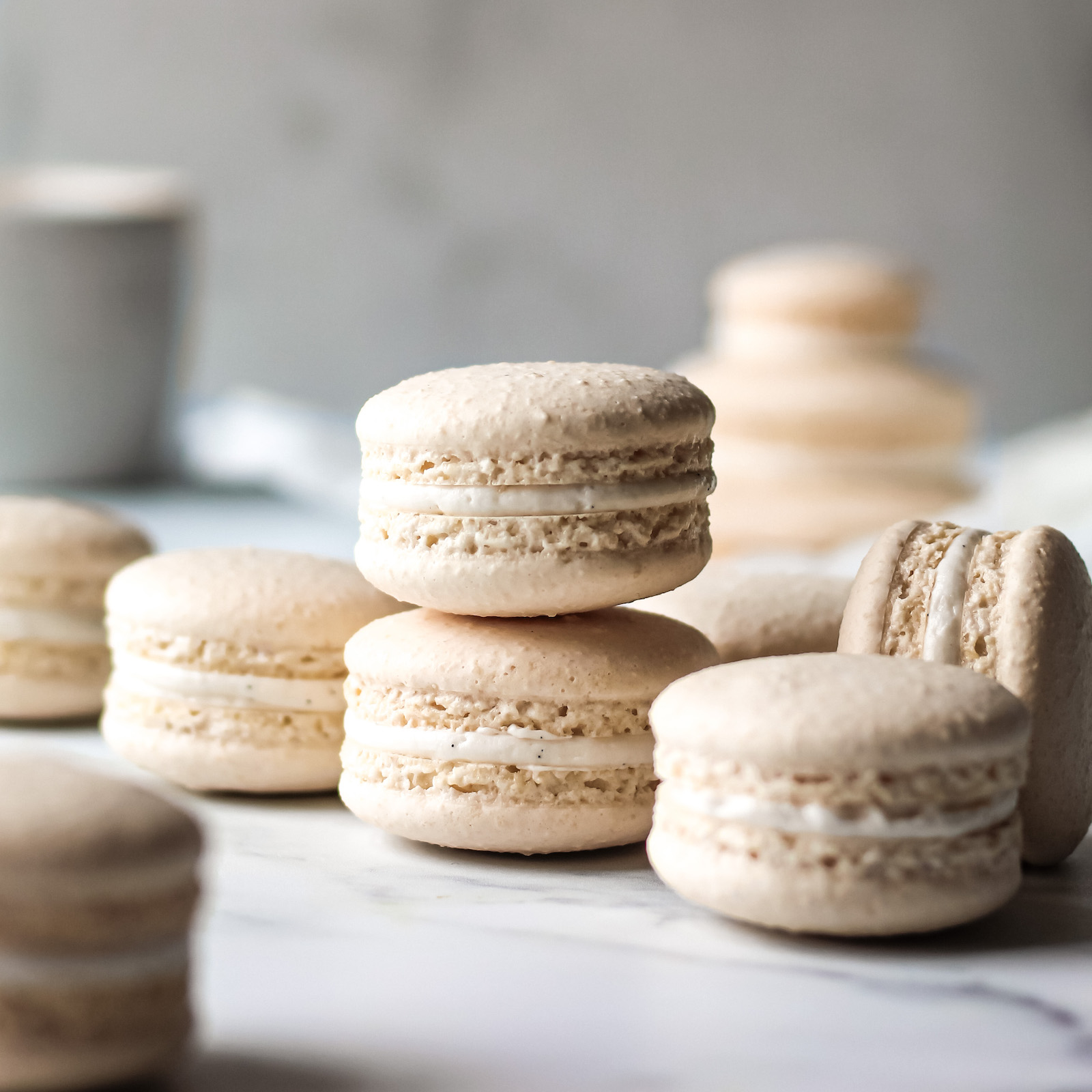
Chemistry:
Let’s go through some basic questions of the chemistry of macarons so you can troubleshoot your macaron failures a lot easier.
How do macarons get their feet?
Long story short, tiny molecules of air trapped by strands of protein in the batter expand in the oven and allow the macarons to rise. With the tops being exposed to air both before and after they get to the oven, they remain smooth and flat because they have been dehydrated. The insides however, expand rapidly to cause the macarons to rise and eventually bake firm so that the macarons have their signature feet.
Almond meal vs almond flour
I always recommend almond flour because the finer it is, the smoother your shells will be. However, I am a hypocrite and often buy almond meal as it works just as well. Using meal will just mean your shells are a little bumpy which I personally don’t mind. It makes them feel rustic.
Why do I need to add cream of tartar? Is there a substitute?
Cream of tartar or an equivalent is fairly essential for vegan meringue/macarons. You’ll find that most non-vegan meringue or macaron recipes suggest using cream of tartar or other acids to help the meringue whip up. It is even more essential for us because the proteins in aquafaba aren’t as robust as those found in egg whites so we need the added support from an acid to contribute to stiffness. Substitutes for cream of tartar include vinegar or lemon juice however these are sub-optimal. Since they are both liquids they’ll further contribute to the hydration of the aquafaba which is already quite a thin liquid.
If you want to know more about the science then check out my how-to guide on aquafaba where I go into detail on the mechanics of acid in meringue. I also have written there how to make your own aquafaba.
Humidity
Unfortunately, humidity plays a huge part in the process of macaron making. To make a successful batch of macarons you need to have as low a humidity as possible. A dehumidifier can definitely help as long as you are patient and follow the steps accurately. Just as an example, I live in the UK which is known for exceptionally mild weather. However, when I bake macarons in the Summer (high humidity) they take 2-3 hours for the tops to firm up, but only 20 minutes in the Winter.
Colouring & Flavouring
Macarons can be flavoured and coloured with a variety of options but there a few golden rules you must follow when doing so. Firstly, no oil based flavourings or colours (for example, use lavender extract instead of oil). Oil is fat and fat collapses meringue. Secondly, use gel or powder colourings if possible. Gels are my go-to as they flawlessly incorporate into the meringue without affecting the chemistry. Powdered colours or even powdered fruit also work. A lot of bakers like to use freeze-dried fruit powders to naturally colour and flavour their macaron shells. The only downside is that sometimes natural colours can fade when baking.
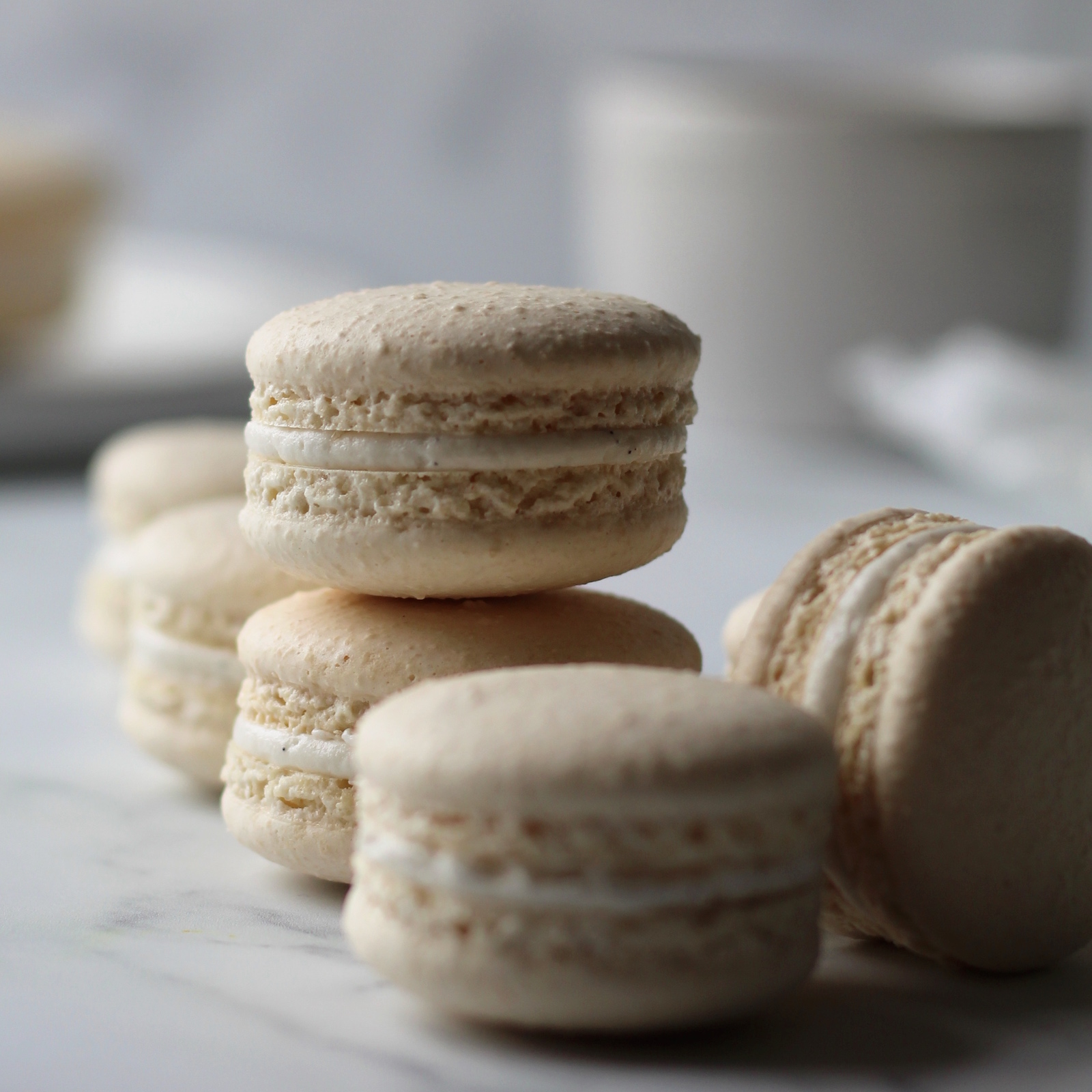
Method:
As I’ve mentioned before, cleaning your bowl and whisk is super important. Imagine having done all the extra work to guarantee a perfect macaron but then a tiny droplet of oil in the mixing bowl collapses the meringue!!
Another handy tip is to use a large pint glass to place the piping bag in so it’s easier to scrape the batter into the bag.
Macaronage
I can’t believe I’m 1500 words into this how-to and I haven’t said this magic word yet: macaronage! Performing a good macaronage takes a lot of patience and sometimes some elbow grease. I would thoroughly recommend watching a few tutorials on Youtube or checking out my instagram highlights because it’s almost impossible to describe this technique in words. Ultimate we’re trying to press out a small amount of air from the meringue so that the batter is a consistency that allows for smooth tops and high feet!
Here’s another handy tip to guarantee a smooth mix of ingredients when you’re adding the cream of tartar to the aquafaba. Take a small amount of aquafaba and place it in a separate bowl with the cream of tartar. Whisk vigorously and then add it back into the larger bowl. By mixing it in a separate bowl, it’s a lot easier to get it to fully blend into the liquid instead of floating around in chunks.
One last tip, if your oven is prone to heat spots, definitely consider rotating the tray in the oven half-way through baking. Unlike cakes, the macarons won’t deflate. Just be careful not to knock about the tray too much as you can topple the macarons if they’re mid-flight!
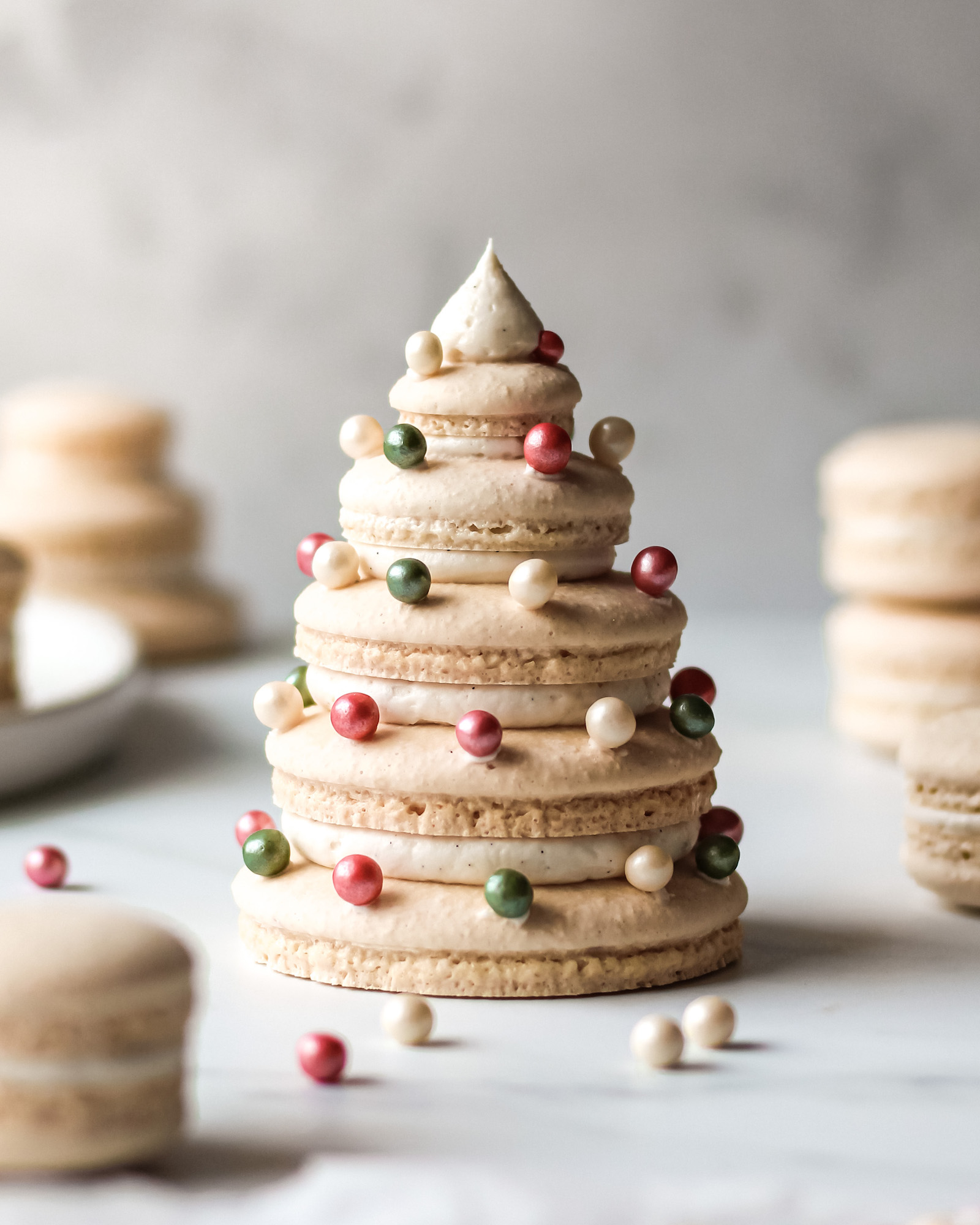
How long can you keep macarons for?
Macarons, and especially vegan macarons, last for a surprisingly long amount of time. I would suggest 2-3 weeks in an airtight container but it’s unlikely anything bad will happen if you store them longer than that! It’s just sugar and nuts after all.
If you’ve read this whole blog post – congratulations! I hope you learned something and if you have any questions feel free to drop a comment below, send me an email or message me on Instagram! Happy baking!
As a reminder, for this recipe you’ll need:
- a piping bag with 1cm circular nozzle – if you prefer not to use silicon or fabric bags please do use biodegradable or compostable piping bags!
- stand mixer / electric whisk
- accurate scale
- fine mesh sieve
- baking trays + parchment paper/silicone mat
Vegan Macarons
This is my core recipe for all vegan macarons that I make. This recipe yield's approximately 24 delicious crunchy shells with a soft core of silky vanilla buttercream.
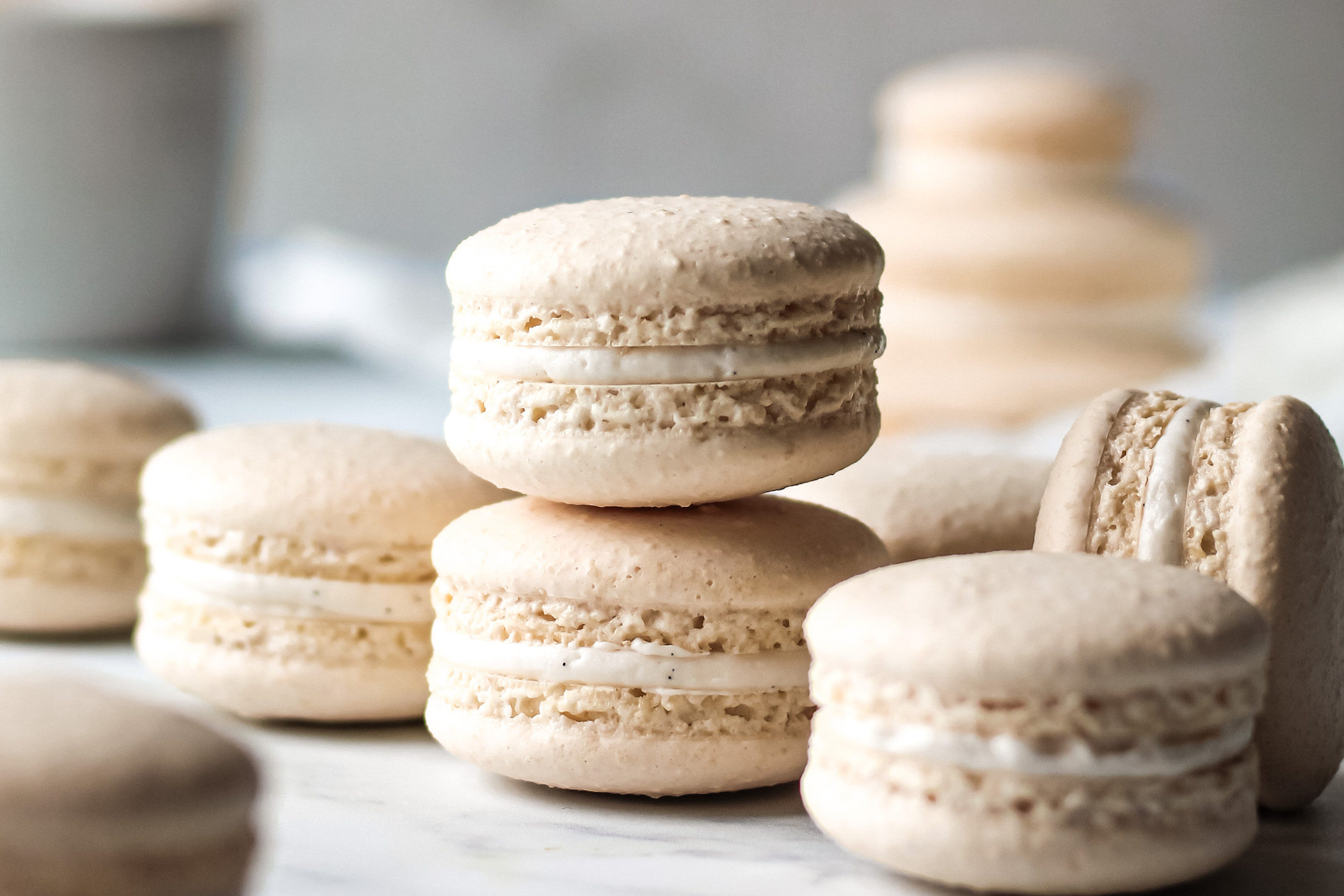

Ingredients
- 300g aquafaba
- 175g granulated sugar
- 175g icing sugar
- 200g almond flour
- 1/2 tsp cream of tartar
- Buttercream:
- 150g vegan butter (75%+ fat)
- 100g veg shortening
- 200g icing sugar
- 40ml hot water
- 1 tbsp vanilla paste
Directions
- Step 1 Pour the 300g of aquafaba and 175g granulated sugar (475g total) into a saucepan on low heat. Simmer for 12 minutes until it has reduced to 325g total weight (use a kitchen scale to check). Pour the aquafaba mix into a stand mixer bowl and leave to cool for 1 hour.
- Step 2 Meanwhile, sieve together the almond flour and icing sugar a few times.
- Step 3 Add the cream of tartar to the aquafaba and start mixing on medium speed for 10 minutes.
- Step 4 Once it reaches stiff peaks, pour the dry mix into the meringue.
- Step 5 Add food colouring or flavours at this point if desired.
- Step 6 Gently fold the mix together until you get a slow-moving lava consistency. To achieve this, use a silicone spatula to scrape around the sides and to the bottom of the bowl and gently fold. You should be able to pour an “8” shape with the batter off the spatula.
- Step 7 Put the batter into a piping bag with a round 1cm piping tip and pipe circle blobs onto a silicon mat, holding the bag perpendicular to the tray. Bang the tray on a table a few times to pop all the bubbles. Use a toothpick to pop those bubbles if necessary.
- Step 8 Pre-heat the oven to 120C.
- Step 9 Leave the macarons to dry for at least 1 hour. Once the macaron shells are no longer shiny they are ready for the oven.
- Step 10 Place the macarons into the oven for 40 minutes or until the feet look dry. Turn the oven off and leave the macarons to dry out for at least an hour with the oven door ajar.
- Step 11 To make the buttercream, add room temperature butter and shortening to a stand mixer with paddle attachment and cream together until pale and fluffy (~5-10 minutes).
- Step 12 Mix the 200g icing sugar with the hot water until smooth. Pour through a sieve into the creamed butter and add the vanilla paste.
- Step 13 Cream together for another 5 minutes then scoop the buttercream into a piping bag.
- Step 14 Pipe buttercream onto a macaron shell and sandwich with another shell of equal size. Do this will all the shells and ideally wait at least 24 hours for the macarons to mature before serving!

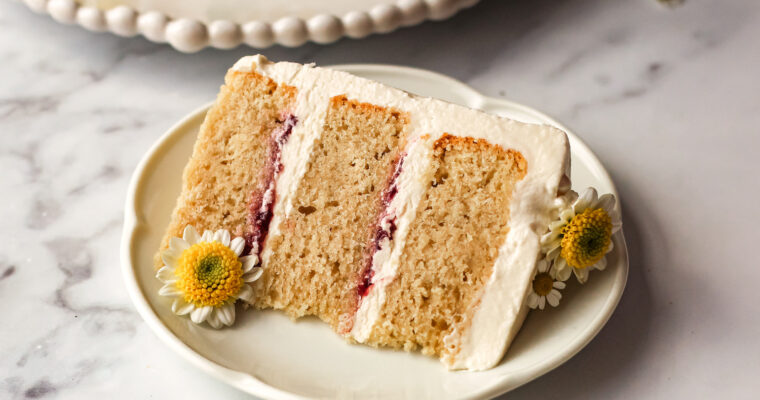
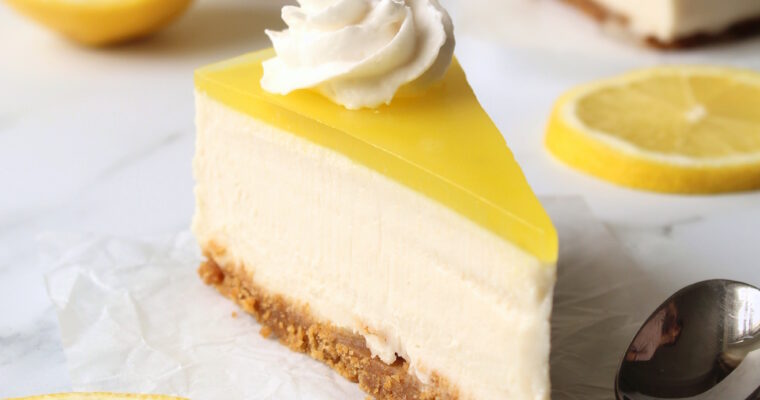
I made this recipe and it turned out better than I expected (because I expected them to fail), but there were some major issues. For one, they were very hard and crunchy. Also, they ended out completely hollow. When I break them in half they just crumble into pieces. They are very cute though. I tried several different temperatures and baking times, but they still always ended up hollow and hard. Any ideas on why that might be and what I could try?
Thanks!
Oh boy, am I actually debating signing up for Instagram to see these videos so highly recommended? Not really. So, wish me luck relying on your typed words! Haha.
Hi! I made this recipe and it was looking good until I started baking it. I let them dry and it looked like there was a skin, and I put them in the oven and immediately the cracked. I put them in a 120 degree Celsius convection oven. Thanks!
Should I really use 300g of Aquafaba or 300ml? Because in grams it is quite a bit more than in litres?(:
its the same..
Sadly it did not work out for me🙁 When I added the dry into the wets, the mixture became very hard and it was not possible to mix at all. I measured all the ingredients to the gram and this also wasn’t my first time making macarons. I was really excited to try this recipe and I will try it again, but do you have any ideas to why that happened?
Is the 300g aquafaba you call for already been reduced and then you add the sugar to reduce it further, or is this straight out of the can and then with the sugar, it’s reduced? I am so looking forward to making these today!
Hello! It’s 300g straight out of the can. It gets reduced with the sugar! Full tutorial in my instagram highlights if you are interested 🙂
Hi, I want to make these macs and freeze them. Is it better to fill them and then freeze them or is it better to freeze the shells unfilled? How long can the filled and unfilled shells be frozen and should they be thawed in the refrigerator or at room temperature? Thanks
This was my first time making macarons, and they turned out AMAZING! I actually halved the recipe because I only had 100g of almond flour, and I was worried it would affect the recipe, but I don’t think it did at all. Definitely intimidated at first but the clips on instagram really helped. I also thought I over mixed the batter since is was a tad runnier than yours in the video, but they got feet!
Thank you for the great recipe 🙂
Definitely give these a go (even if you’re hesitant about it like I was)
Hey Natasha! Thanks so much for your lovely comment and I’m so glad they worked out for you. 🙂
Okay these macs WORK! I am absolutely not a pro at making macarons, but Tom’s recipe is so thorough and technically helpful that I was able to get vegan macs with feet!! This was my first time reducing the aquafaba with granulated sugar prior to making the meringue, and that made a huge difference in how they came out for me. I probably could have baked them without the convection fan, as I think mine is probably too powerful, and probably would have resulted in more even macs! But this is my favorite vegan mac recipe, I’m absolutely making this again! Thanks, Tom!!
Thank you Britt!! So glad you love this recipe! 🙂
Hi, thanks for posting your recipe! My first attempt turned out okay, however they didn’t rise, so had no feet. Any tips on whether this could be because of oven temp, mixture consistency (too runny), or something else? Do you use fan forced? Thanks 🙂
Hi! Sorry to hear it didn’t work out. It could be a combination of those things! No feet is often is too low of a temperature or overmixing. Avoid fan forced because it makes them go all wonky when they rise! DM me on instagram if you need more tips 🙂
Thanks for your reply, I think maybe it was a combination of over mixing a little and the temperature, will try it a bit hotter next time. Thanks!
Hi!
I’m very excited to try this recipe. I just wanted to ask, you mentioned the shells are “crunchy” but do they still have the light, melt-in-your mouth texture that non-vegan macarons are known for?
Thank you 🙂
Hi Guy! I would say so!! Once filled and matured they are completely melt-in-your-mouth and so delicious.
A combination of a fantastic recipe and some beginners luck for me, I was so happy with how they turned out on my first go! The Instagram stories walking that walk us through the recipe helped a lot too!
These look perfect and will definitely try them, as we are yet to find a vegan macaron for our auntie and she would definitely love these! (She is french and always looking for a vegan version) Thank you for all the tips too! Literally cannot wait to try them out. X
Hey thanks so much! They’re a little tricky but if you follow my tutorial on my instagram they should be manageable!! Good luck!
Perfection! after many, many! failed tries with other methods I followed yours and my macs came out perfect! I just shared your link in the vegan mac facebook page I follow and there were many excited vegan mac lovers anxious to try your recipe out!
Hi Carolina! Your comment absolutely made my day! So glad they worked out for you. I’ll come check out the vegan mac FB group to say hi!
These were my first successful macarons. I also want to try to make a chocolate version, but am SO scared to tempt fate. 😂 If you were to add cocoa, would you reduce the other dry ingredients?
With 5* review
Too scared to try this but your videos on isntagram were soooo fun 🙂